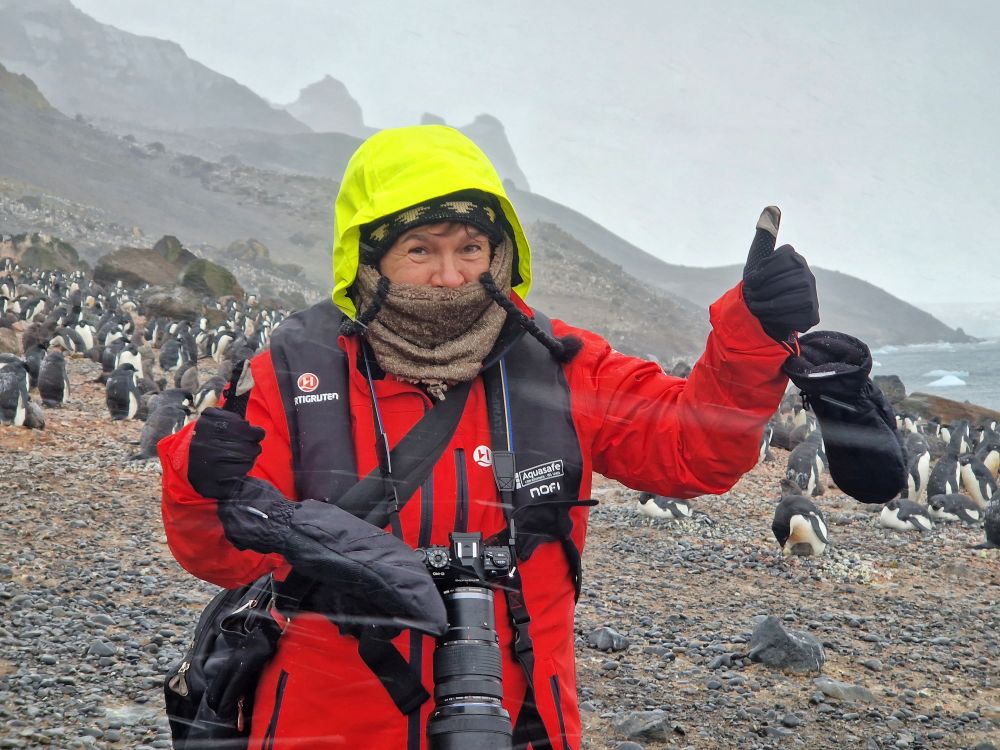I waited twenty years for my greatest wish to come true – to go to Antarctica.
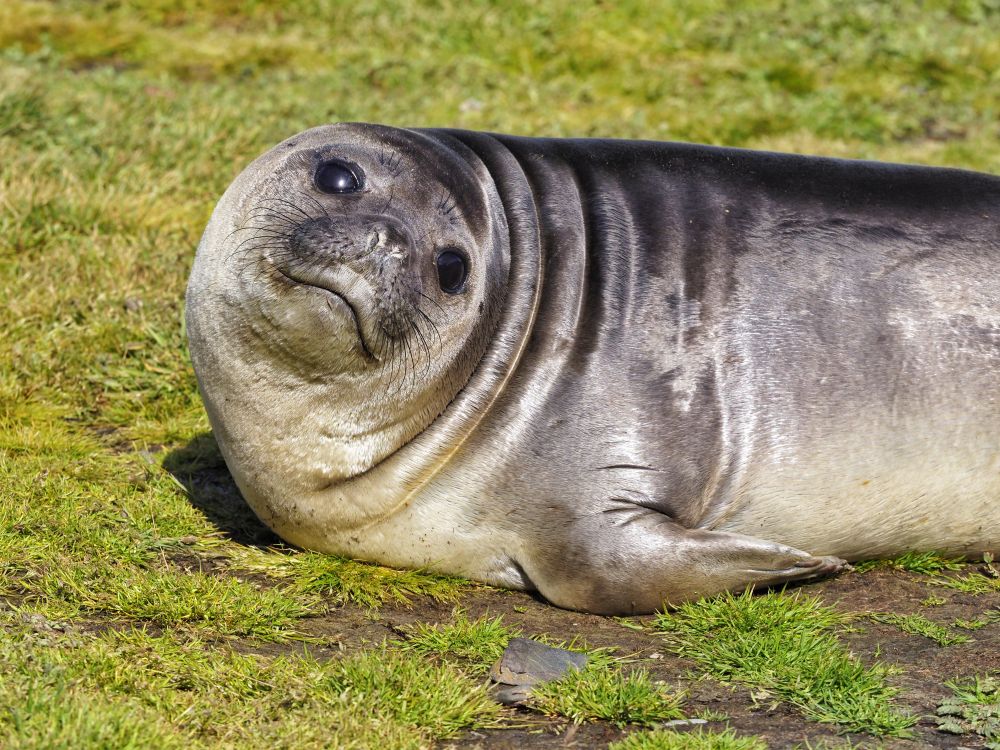
Twenty years ago, in Christchurch, New Zealand, on the last day of my tour of the country, I visited the International Antarctic Centre and was amazed by the photos and films of the snow-white continent. I had always loved penguins, but this was the day when I fell completely in love with them and felt an insatiable desire to visit their habitat one day. I had already experienced on previous trips how different it is to see animals not behind a fence but in their natural habitat. When I think back on my travels over the past decades, the greatest experiences have always been with animals: going on a bear hunt in Alaska, visiting gorillas in Rwanda, photographing puffin in Iceland or admiring the funny ring-tailed lemurs in Madagascar.
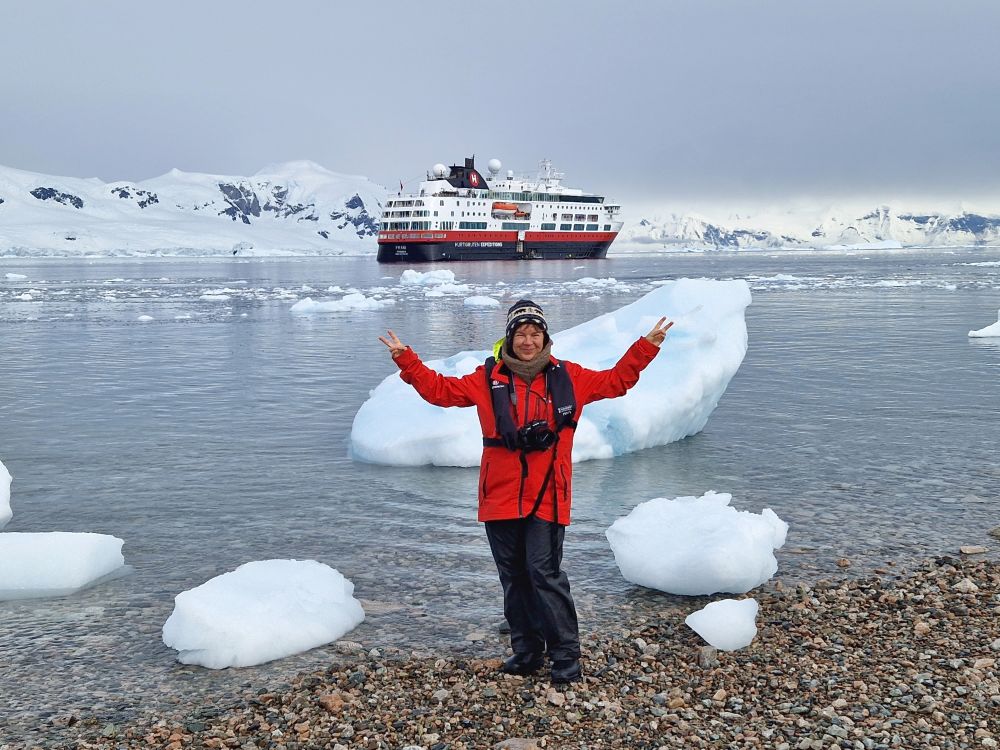
I had seen penguins before – in the Galapagos Islands, South Africa, Argentina and New Zealand, but my big wish was to see the largest species: the emperor penguin or the king penguin. Unfortunately, the likelihood of the former is very low, as the emperor penguin lives almost exclusively in Antarctica, hundreds of kilometres off the coast, and rarely occurs in places where tourists are present. King penguins are easier to catch, nesting in huge colonies on the islands of South Georgia. The only difficulty is that it is not enough to go on the shorter (8-10 days) and cheaper Antarctic expedition, but you also have to go to the South Georgia archipelago, where there are fewer boats and the trip takes 20-22 days.
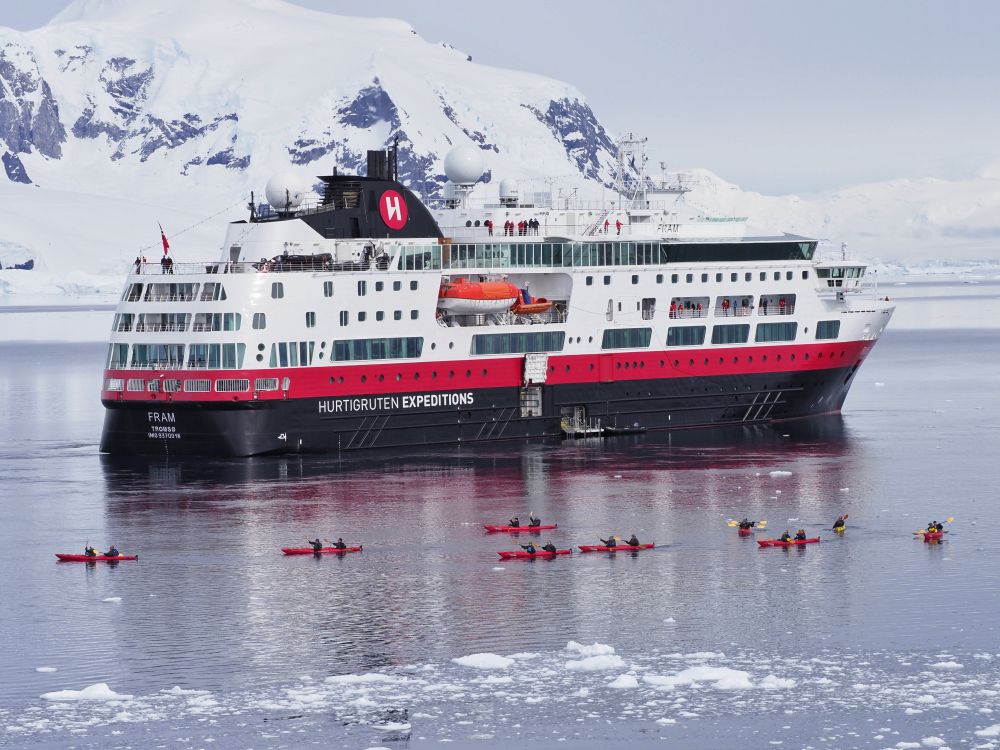
I was so focused on the king penguins that I confess I didn’t even check what other species lived on the Antarctic continent – so each new species was a huge surprise, especially when I realised how unique and how special each one was. These birds, unable to fly, are amazingly amusing – the way they hurry around, the way they steal stones from each other to build their nests, the way they wait for each other on the beach to see who will be the first to jump in the water.
Opinions differ on exactly how many species of penguin there are (around 18-20), but it is certain that eight live in Antarctica. Unfortunately, I didn’t get to see the largest, the emperor penguin, but here are the seven that I had the pleasure of meeting.
King Penguin
Let’s start with my favourite, the king penguin, one of the most iconic and easily recognisable penguin species in the world. The second largest penguin after the emperor penguin, it can grow up to one metre in height. It is easily recognisable by its bright orange lower beak and orange spots around its ears.
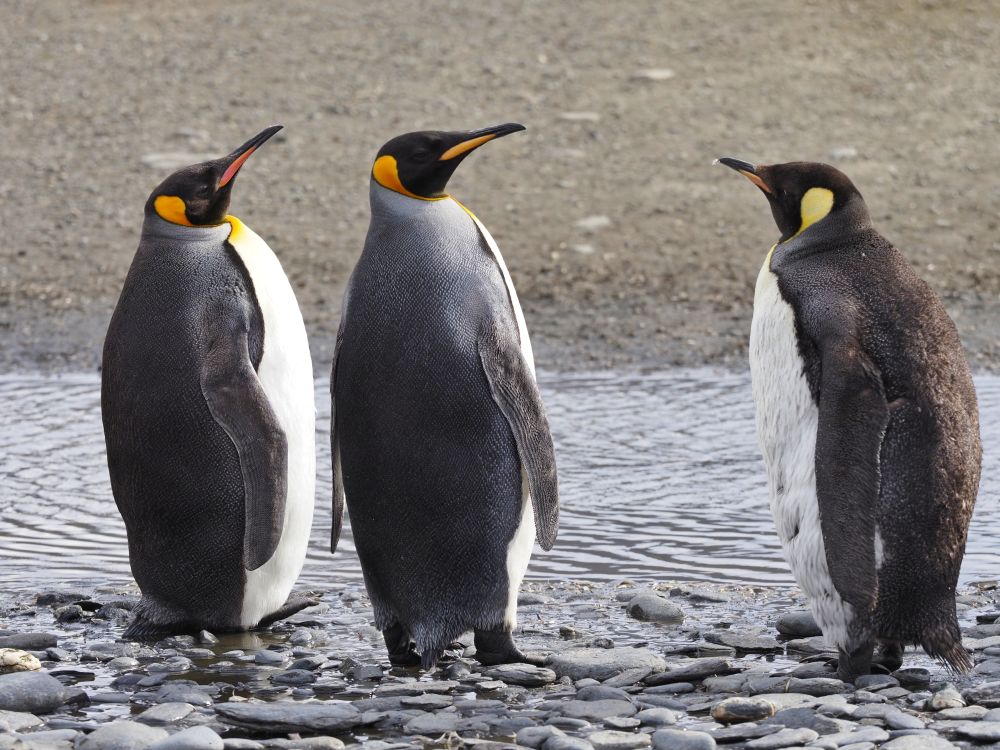
The emperor penguin is even bigger and much plumper than the emperor – the king penguin is particularly elegant with its silver-grey fur and yellow spots.
King penguins are highly social animals, gathering in huge colonies, sometimes numbering hundreds of thousands of birds. I can’t tell you what a thrill it is to see them in such numbers – even if the noise and smell of so many penguins together is not pleasant.
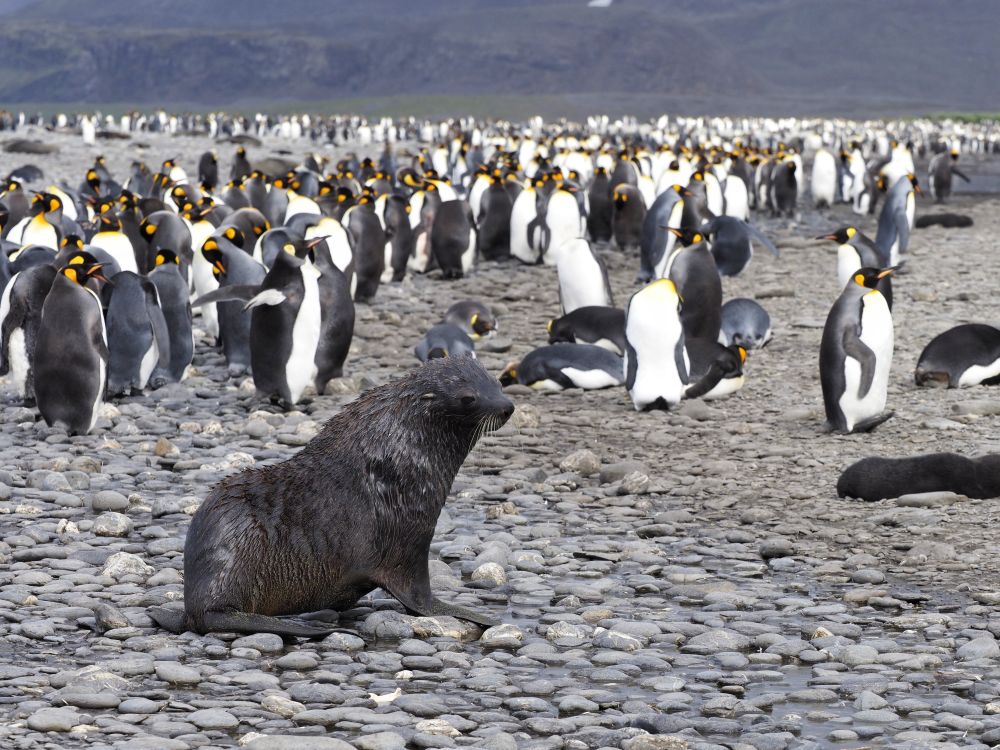
Their numbers have dropped dramatically in the decades since whalers were allowed to operate in the area. In the absence of firewood, the tallow-rich penguins were used for heating, lamp oil and cooking oil. Fortunately, by the 1920s, this activity was completely banned, and Antarctic wildlife has since been highly protected. Today, more than 2 million pairs of king penguins have been reintroduced to the area, and as their numbers continue to grow, they are not considered endangered. Unfortunately, however, they are also threatened by the negative effects of global warming, which is limiting their habitat and food sources.
King penguins, unlike other species, do not build nests. They keep their single eggs balanced on their feet, kept warm under a flap of skin. Both parents care for the egg and the chick. They take turns every 3-7 days: one caring for the offspring and the other fishing in the sea to bring food for her mate and the young.
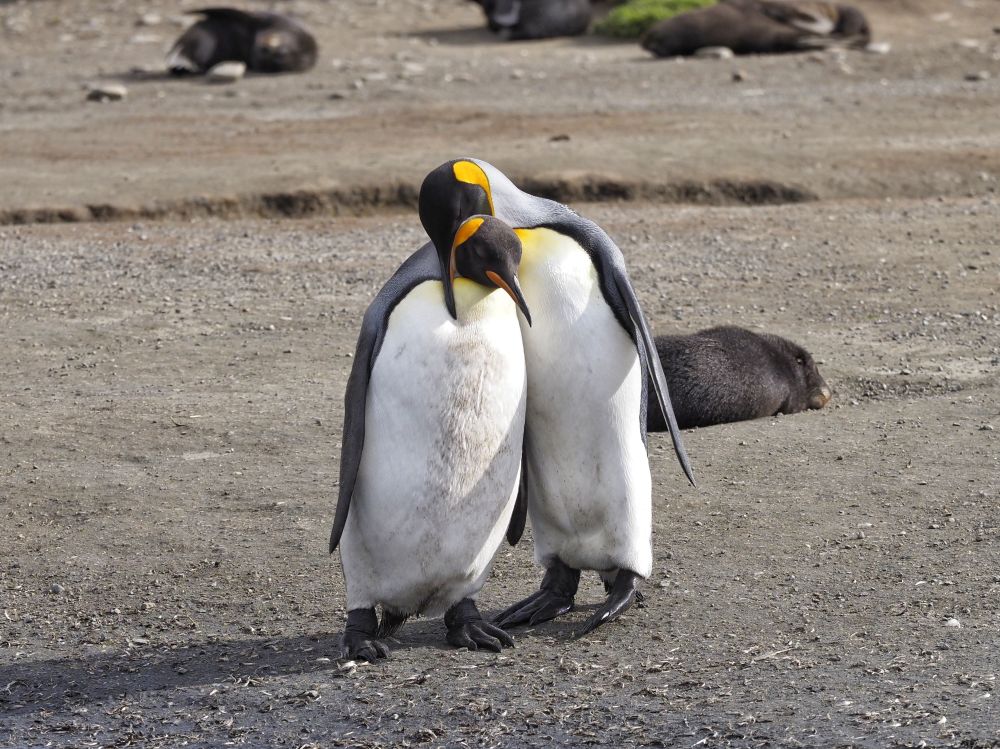
Macaroni penguin
Let’s continue with a species that also has a little yellow pattern – they are macaroni penguins with a yellow bobbit on their head. They always wear their yellow hair slicked back, and are easily recognisable by this. Their average height is 70 centimetres, which puts them in the mid-range of penguins.
They are the most numerous of all penguin species in the world, estimated at 18 million (but their status is ‘vulnerable’ as this is steadily declining). Despite their numbers, they are not easy to see because they do not live on the islands that are more frequently visited by tourists. If you want to see a macaroni penguin, you have to go on a longer expedition that includes South Georgia and the Falkland Islands. We encountered them on one of the islands of South Georgia, specifically in the Bay of Hercules. It was not possible to land there, but we were able to get our rubber dinghies close to the coastal cliffs and take photos.
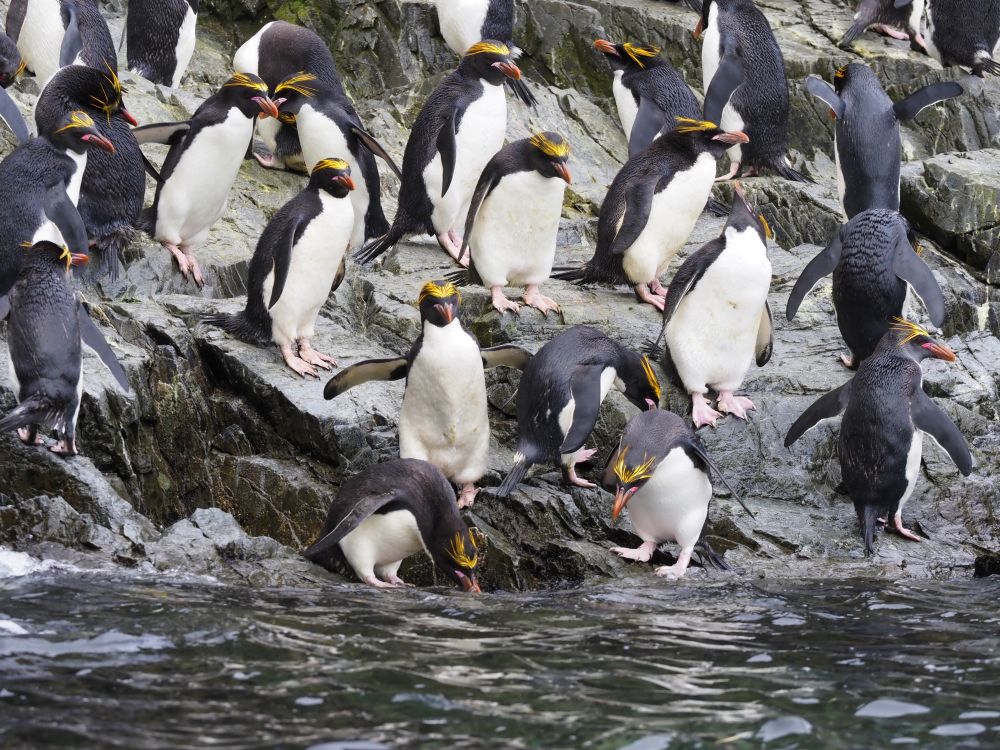
The penguins get their name from the “Macaroni Club”, a group of aristocratic English dandies of the 18th century who wore flamboyant costumes. When English sailors arriving in the Falkland Islands first saw these penguins, they thought of English chaps and the name stuck.
Southern Rockhopper
There’s one other species of penguin that has a little yellow pattern – the southern rockhopper penguin, which has gold feathers on its head. It is relatively small, standing 52 cm tall.
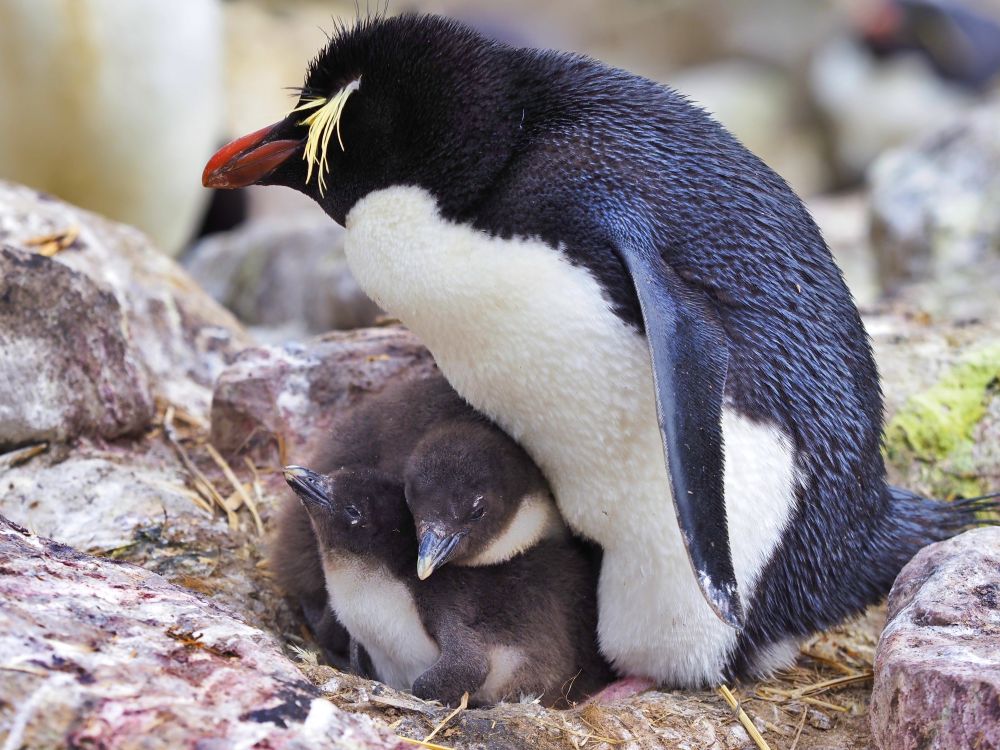
Unlike the other penguins, they cannot crawl on their bellies on snow and ice, but instead live in rocky landscapes and hop from rock to rock – hence their name. They’re very funny on the move, I could have watched them for hours.
Rock-hopping penguins choose a mate for life and return to the same nest every year. But before we get carried away with how romantic they are, I should also say that they are probably the most aggressive species of penguin. They fight for nesting sites, mating rights and food, flapping their fins at each other in the process. Another important characteristic is that they are very noisy. With their heads thrown back, they “trumpet” different signals to each other – sometimes to locate each other, sometimes to warn others to back off, and sometimes to find their mates and chicks in the huge crowd.
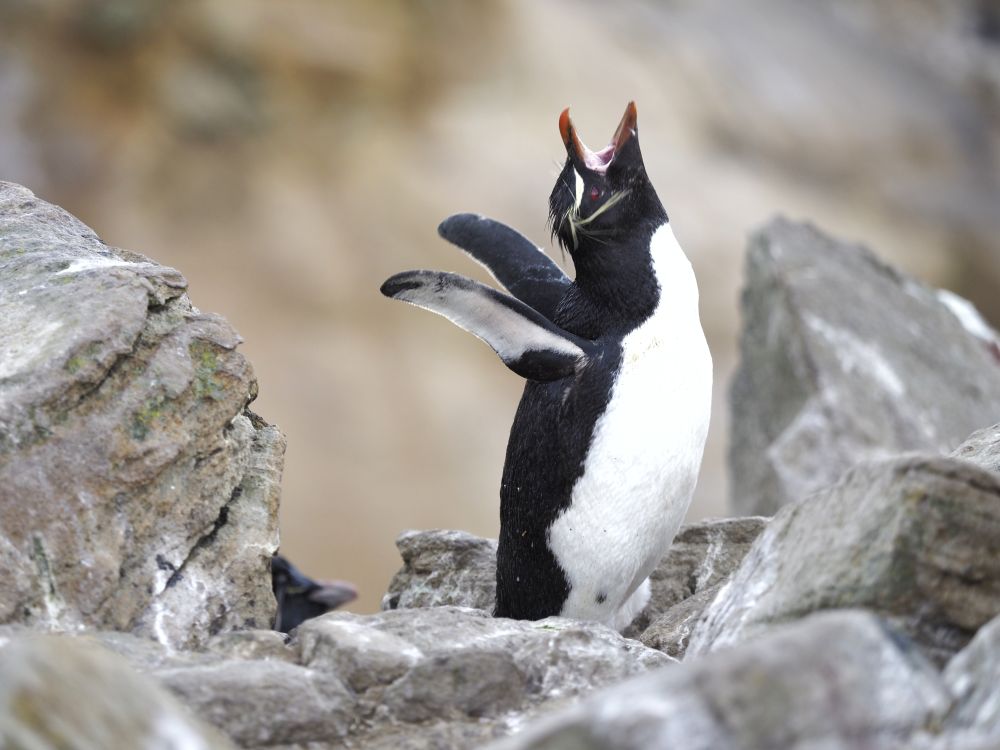
Although millions of them still live, their numbers are rapidly declining and they are now listed as an endangered species.
Magellanic penguin
You don’t have to travel to Antarctica to see Magellanic penguins – they can be found in Chile, Argentina and even Brazil. They are easily recognisable as they have two black bands between the head and the chest and a white pattern on the black head.
They are named after the Portuguese explorer Ferdinand Magellan, who saw them in South America in 1520. Most Magellanic penguins live in South America, not in Antarctica: about 900,000 pairs in Argentina and 800,000 in Chile.
While individuals of other species of penguins waddle around curiously, the Magellanic penguin is much more shy and will flee to their nesting sites if humans are around.
Although they are not considered endangered, they face another threat beyond climate change. Because they live in large numbers off the coast of the South American continent, further north than the others, they are often victims of oil spills from ships.
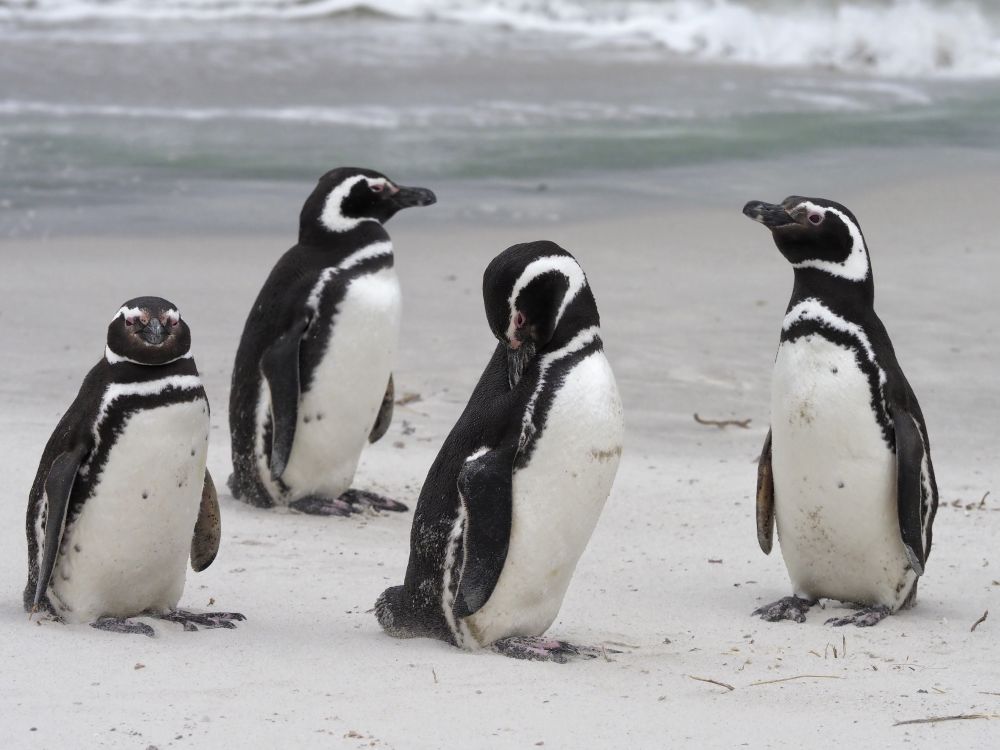
Chinstrap penguin
At first glance, the bearded penguin looks like he’s wearing a beard – or is it more like a black helmet strap under his chin, as the English name (chinstrap) suggests? In any case, this is another one of those unmistakable characters we met on the island of Aitcho in Antarctica.
They are the most abundant penguin species in Antarctica, numbering around 8 million individuals in total, and are not considered endangered, apart from climate change. There are one million of them on Deception Island alone, but unfortunately we were unable to moor here due to bad weather.
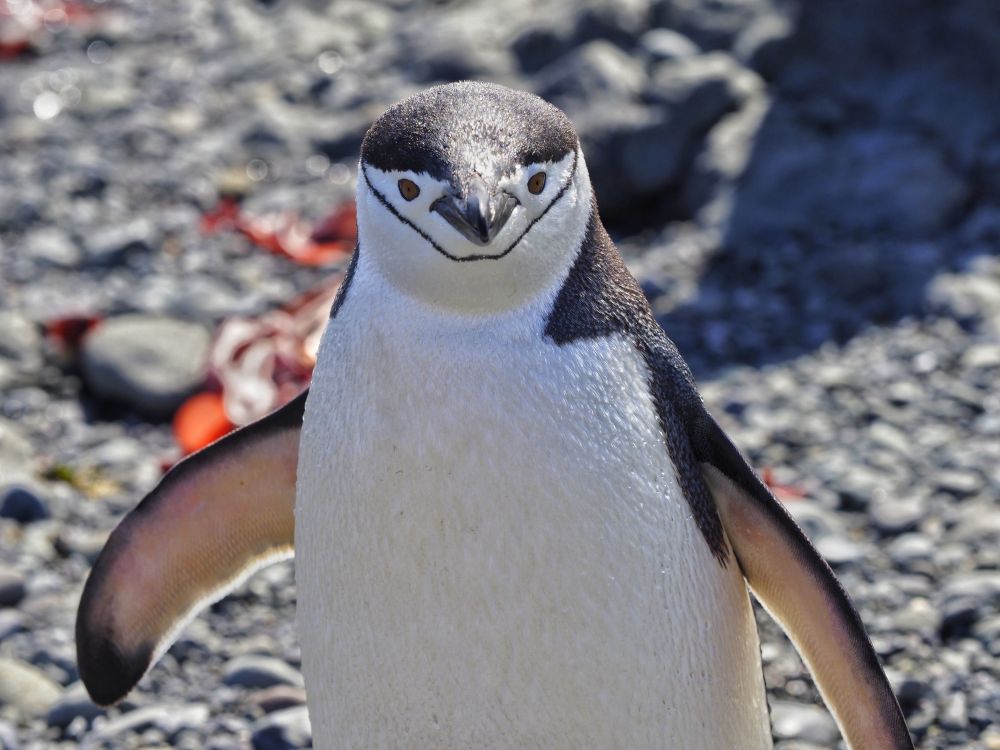
The chinstrap penguins are great swimmers, capable of speeds of up to 30km/h, using their fins to ‘fly’ through the water. On land, they often lie on their bellies and “sled” on the ice.
The chinstrap penguins are the most aggressive of the Antarctic penguins, and their reproduction is almost soap-opera-like. The males arrive at the nesting site days before the females and try to attract attention by making the most beautiful nest. If a male can’t find stones to his liking, he’ll go round the others’ nests and steal building materials. We watched this cockfight with smiles and fascination, and it was unforgettable.
Adélie Penguin
With a population of 10 million, the Adélie penguins are not endangered either – luckily, because they are also very friendly and funny animals. With their tiny stature and inquisitive, beady eyes, they’re extremely cute and lovable. Their charming appearance is matched by very funny transport – they walk along the beach with such determination and determination, as if they are always in a hurry to get somewhere.
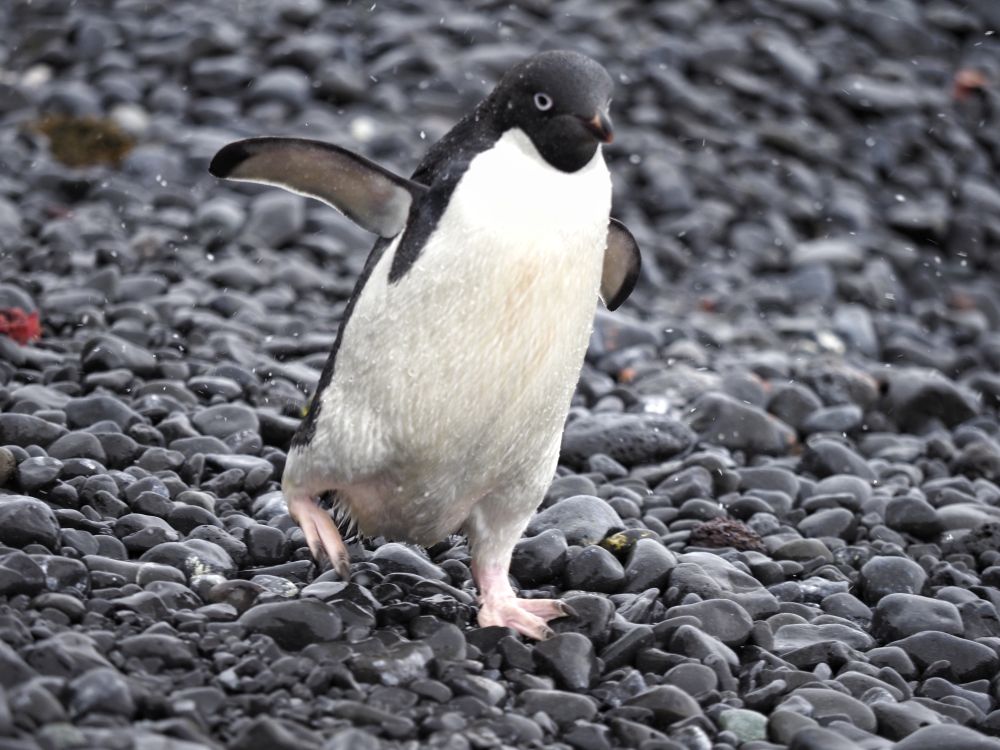
Their name comes from a French explorer, Jules Dumont d’Urville, who named them after his wife Adéle.
Like the other species, they breed on land during the warmer months, from October to February, and then spend the winter at sea among the ice floes. As small as they are strong, they are excellent walkers and swimmers. They often cover huge distances between their winter and summer habitats, with the longest observed trek to date being 17,600 km.
Gentoo Penguin
The gentoo penguin – or gentoo as it is better known in English – is recognisable by its white “headphones” and the fact that it has the longest tail of all penguin species. They also like to move around in large colonies. They breed near beaches, but not directly on the shore, and build ‘penguin highways’ in the snow between their nests and the water. They travel on paths trodden in the snow and often only the brow of their head is visible behind the high snow wall – a sight that will always remain unforgettable for me, it was so impressive.
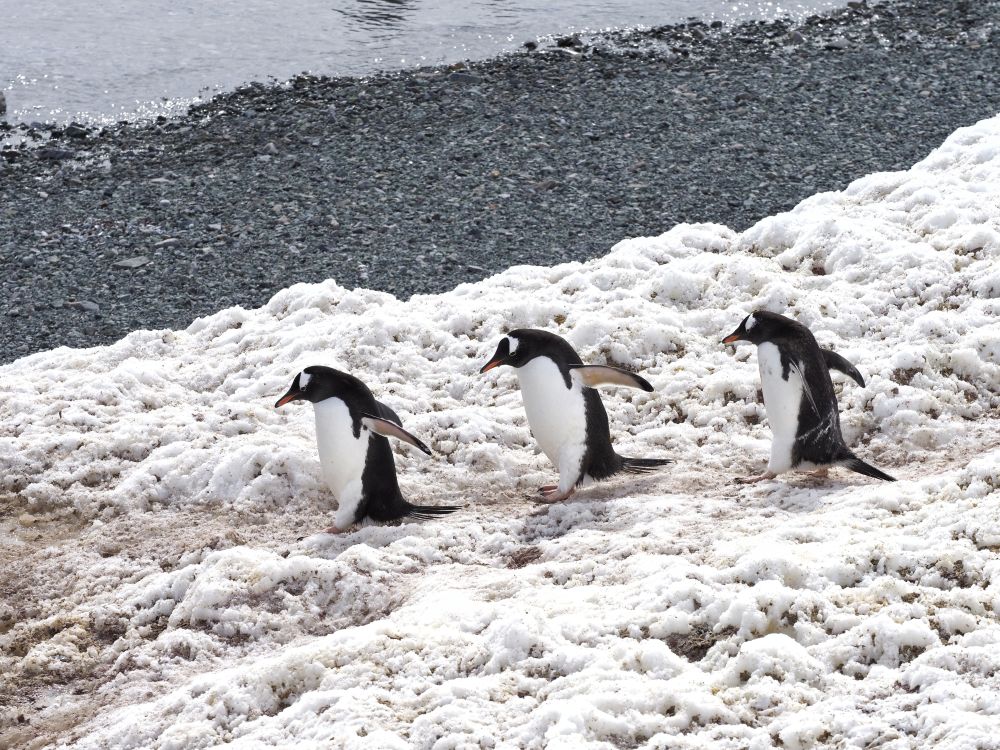
There are around 300,000 breeding pairs in the Antarctic region, with only fewer emperor penguins.
They build their circular nests with extraordinary care. Although we were unable to grasp how the tens of thousands of stones lying on the beach differed from one another, the males spend a long time looking around before they choose the right ones.
Female gentoo penguins typically lay two eggs, so we often saw twin chicks. Unfortunately, these tiny chicks are very vulnerable and make easy prey for the large osprey. We witnessed a baby penguin being snatched away by one of these birds of prey – as heartbreaking as it was to see, we couldn’t help it, it’s just the way of nature.
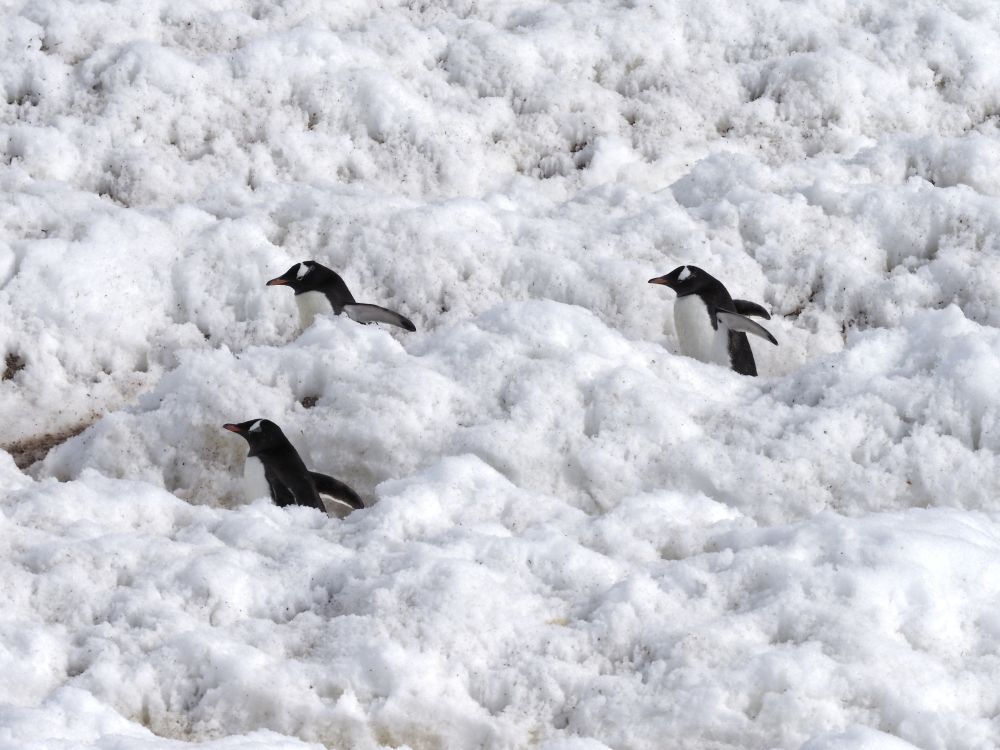
Gentoo penguins are among the fastest swimming birds, reaching speeds of up to 36 km/h.
Although I definitely started out with a strong interest in king penguins (and whales and icebergs), I came home with all the penguin species as my favourites. I’m a bit like a mother with her children now, I couldn’t choose between them, they’ve all grown on me. As I wrote in the introduction, the highlight of any trip is meeting animals in their natural habitat… but nowhere has it been as poignant, raw, cathartic an experience as watching penguins in Antarctica…
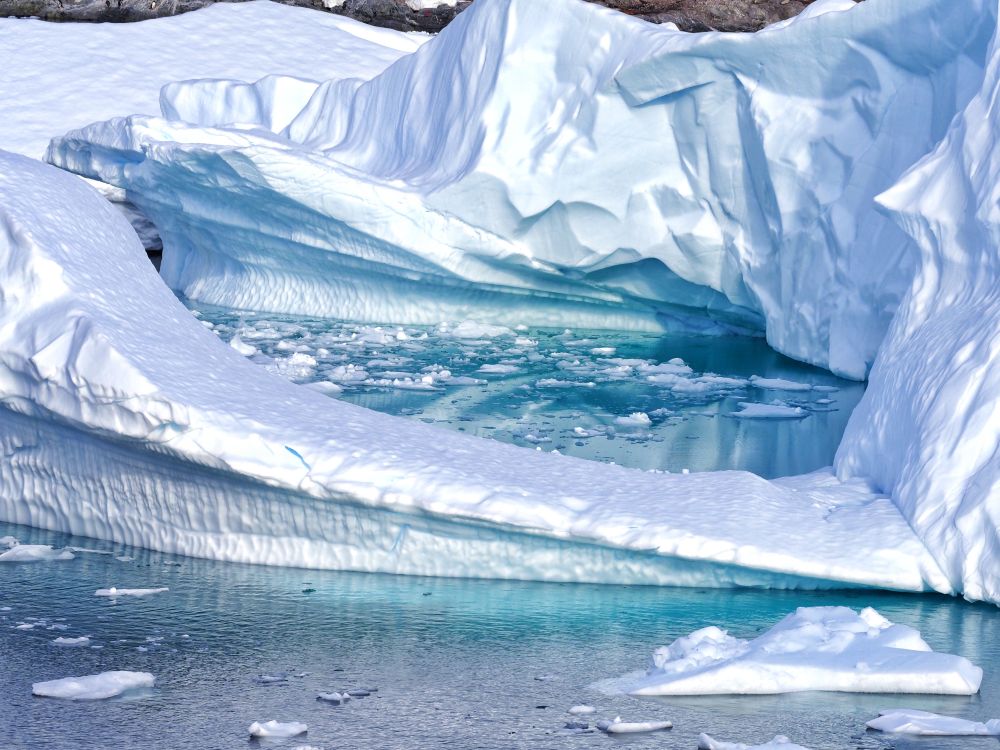
The article was originally published in National Geographic

